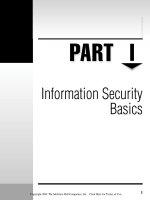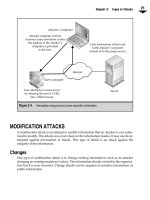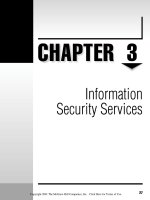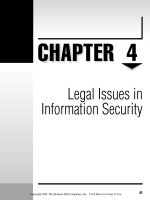Bảo mật hệ thống mạng part 40 docx
Bạn đang xem bản rút gọn của tài liệu. Xem và tải ngay bản đầy đủ của tài liệu tại đây (105.91 KB, 7 trang )
Putting all of these scripts together gives a good picture of what the hacker was doing.
Once a target system was compromised, he could remotely retrieve the sniffer logs and
thus compromise many other systems that were not penetrated during the first attack.
The automation of this compromise and retrieval process would allow the hacker to gain
access to an extremely large number of systems very quickly and then to broaden the
scope of his success by retrieving and storing additional passwords.
METHODS OF THE TARGETED HACKER
A targeted hacker is attempting to successfully penetrate or damage a particular organi
-
zation. Hackers who target a specific organization are motivated by a desire for some
-
thing that organization has (usually information of some type). In some cases, the hacker
is choosing to do damage to a particular organization for some perceived wrong. Many of
the targeted DoS attacks occur in this way. The skill level of targeted hackers tends to be
higher than that for untargeted hackers.
Targets
The target of the attack is chosen for a reason. Perhaps the target has information that is of
interest to the hacker. Perhaps the target is of interest to a third party who has hired the
hacker to get some information. Whatever the reason, the target is the organization, not
necessarily just one system within the organization.
Reconnaissance
Reconnaissance for a targeted attack takes several forms: address reconnaissance, phone
number reconnaissance, system reconnaissance, business reconnaissance, and physical
reconnaissance.
Address Reconnaissance
Address reconnaissance is simply the identification of the address space in use by the tar
-
get organization. This information can be found from a number of locations. First, DNS
can be used to identify the address of the organization’s Web server. DNS will also pro
-
vide the address of the primary DNS server for the domain and the mail server addresses
for the organization. Taking the addresses to the American Registry of Internet Numbers
(ARIN) () will show what addresses belong to the organization.
Name searches can also be conducted through ARIN to find other address blocks as
-
signed to the target organization.
Additional domain names that may be assigned to the organization can be found by
doing text searches at Network Solutions (). For each
additional domain that is found, DNS can be used to identify additional Web servers,
mail servers, and address ranges. All of this information can be found without alerting
the target.
256
Network Security: A Beginner’s Guide
More information about which addresses are in use at the target can be found by do
-
ing a zone transfer from the primary DNS server for the domain. If the DNS server allows
zone transfers, this will provide a listing of all systems in the domain that the DNS server
knows about. While this is good information, it may not be successful and may alert the
target. Properly configured DNS servers restrict zone transfers and therefore will not
provide the information. In this case, the attempt may be logged and that might identify
the action to an administrator at the target.
Through the use of these techniques, the hacker will have a list of domains assigned to
the target organization, the addresses for all Web servers, the addresses of all mail serv
-
ers, the addresses of primary DNS servers, a listing of all address ranges assigned to the
target organization, and, potentially, a list of all addresses in use. Most of this information
can be found without contacting the target directly.
Phone Number Reconnaissance
Phone number reconnaissance is more difficult than identifying the network addresses
associated with a target organization. Directory assistance can be used to identify the pri
-
mary number for the target. It is also often possible to identify some numbers from the
target Web site. Many organizations list a contact phone or fax number on their Web site.
After finding a few numbers, the hacker may decide to look for working modem
numbers. If he chooses to do this, he will have to use a wardialer of some type. The hacker
will estimate the size of the block of numbers that the organization is likely to use and will
start the wardialer on this block. This activity may be noticed by the target as many office
numbers will be called. The hacker may choose to perform this activity during off hours
or on weekends to lessen the potential for discovery.
The other downside of this activity is that the hacker does not know for sure which of
the numbers are used by the target organization. The hacker may identify a number of
modem connections that lead to other organizations and thus do not assist in compromis
-
ing the target.
At the end of this activity, the hacker will have a list of numbers where a modem an
-
swers. This list may provide leads into the target or not. The hacker will have to do more
work before that information will be available.
System Reconnaissance
For the targeted hacker, system reconnaissance is potentially dangerous, not from the
standpoint of being identified and arrested but dangerous from the standpoint of alerting
the target. System reconnaissance is used to identify which systems exist, what operating
system they are running, and what vulnerabilities they may have.
The hacker may use ping sweeps, stealth scans, or port scans to identify the systems.
If the hacker wishes to remain hidden, a very slow ping rate or stealth scan rate is most ef
-
fective. In this case, the hacker sends a ping to one address every hour or so. This slow
rate will not be noticed by most administrators. The same is true for slow stealth scans.
Operating system identification scans are harder to keep hidden as the packet signa
-
tures of most tools are well known and intrusion detection systems will likely identify
Chapter 13: Hacker Techniques
257
258
Network Security: A Beginner’s Guide
any attempts. Instead of using known tools, the hacker may forego this step and use the
results of a stealth scan to make educated guesses on the operating systems. For instance,
if a system responds on port 139 (NetBIOS RPC), it is likely a Windows system (either NT,
2000, 95, or 98). A system that responds on port 111 (Sun RPC/portmapper) is likely a
Unix system. Mail systems and Web servers can be classified by connecting to the port in
question (25 for mail and 80 for Web) and examining the system’s response. In most cases,
the system will identify the type of software in use and thereby the operating system.
These types of connections will appear as legitimate connections and thus go unnoticed
by an administrator or intrusion detection system.
Vulnerability identification is potentially the most dangerous for the hacker. Vulnera
-
bilities can be identified by performing the attack or examining the system for indications
that vulnerabilities exist. One way to examine the system is to check the version numbers
of well-known software such as the mail server or DNS server. The version of the soft
-
ware may tell if it has any known vulnerabilities.
If the hacker chooses to use a vulnerability scanner, he is likely to set off alarms on any
intrusion detection system. As far as scanners are concerned, the hacker may choose to
use a tool that looks for a single vulnerability or he may choose a tool that scans for a large
number of vulnerabilities. No matter which tool is used, information may be gained
through this method, but the hacker is likely to make his presence known as well.
Business Reconnaissance
Understanding the business of the target is very important for the hacker. The hacker
wants to understand how the target makes use of computer systems and where key infor-
mation and capabilities reside. This information provides the hacker with the location of
likely targets. Knowing, for instance, that an e-commerce site does not process its own
credit card transactions, but instead redirects customers to a bank site means that credit
card numbers will not reside on the target’s systems.
In addition to learning how the target does business, the hacker will also learn what
type of damage can hurt the target most. A manufacturer that relies on a single main
-
frame for all manufacturing schedules and material ordering can be hurt severely by
making the mainframe unavailable. The mainframe may then become a primary target
for a hacker seeking to cause the target serious harm.
Part of the business model for any organization will be the location of employees and
how they perform their functions. Organizations with a single location may be able to
provide a security perimeter around all key systems. On the other hand, organizations
that have many remote offices connected via the Internet or leased lines may have good
security around their main network but the remote offices may be vulnerable. The same
is true for organizations that allow employees to telecommute. In this case, the home
computers of the employees are likely using virtual private networks to connect back to
the organization’s internal network. Compromising one of the employee’s home systems
may be the easiest way to gain access to the organization’s internal network.
Chapter 13: Hacker Techniques
259
The last piece of business reconnaissance against the organization is an examination of
the employees. Many organizations provide information on key employees on a Web site.
This information can be valuable if the hacker chooses to use social engineering techniques.
More information can be acquired by searching the Web for the organization’s domain
name. This may lead to the e-mail addresses of employees who post to Internet newsgroups
or mailing lists. In many cases, the e-mail addresses show the employees’ user IDs.
Physical Reconnaissance
While most untargeted hackers do not use physical reconnaissance at all, targeted hack
-
ers use physical reconnaissance extensively. In many cases, physical means allow the
hacker to gain access to the information or system that he wants without the need to actu
-
ally compromise the computer security of the organization.
The hacker may choose to watch the building the organization occupies. The hacker
will examine the physical security features of the building such as access control devices,
cameras, and guards. He will watch the process used when visitors enter the site and
when employees must exit the building to smoke. Physical examination may show weak
-
nesses in the physical security that can be exploited to gain entry to the site.
The hacker will also examine how trash and paper to be recycled are handled. If the
paper is placed in a dumpster behind the building, for instance, the hacker may be able to
find all the information he wants by searching the dumpster at night.
Attack Methods
With all the information gathered about the target organization, the hacker will choose
the most likely avenue with the least risk of detection. Keep in mind that the targeted
hacker is interested in remaining out of sight. He is unlikely to choose an attack method
that sets off alarms. With that in mind, we will examine electronic and physical attack
methods.
Electronic Attack Methods
The hacker has scouted the organization sufficiently to map all external systems and all
connections to internal systems. During the reconnaissance of the site, the hacker has
identified likely system vulnerabilities. Choosing any of these is dangerous since the tar
-
get may have some type of intrusion detection system. Using known attack methods will
likely trigger the intrusion detection system to cause some type of response.
The hacker may attempt to hide the attack from the intrusion detection system by
breaking up the attack into several packets, for instance. But he will never be sure that the
attack has gone undetected. Therefore, if the attack is successful, he must make the system
appear as normal as possible. One thing the hacker will not do is to completely remove log
files. This is a read flag to an administrator. Instead, the hacker will only remove the entries
in the log file that show his presence. If the log files are moved off the compromised system,
the hacker will not be able to do this. Once into the system, the hacker will establish back
doors to allow repeated access.
If the hacker chooses to attack via dial-in access, he will be looking for remote access
with easy-to-guess passwords or with no password. Systems with remote control or ad
-
ministration systems will be prime targets. These targets will be attacked outside of nor
-
mal business hours to prevent an employee observing the attack.
If the hacker has identified an employee’s home system that is vulnerable to compro
-
mise, the hacker may attack it directly or he may choose to send a virus or Trojan Horse
program to the employee. Such a program may come as an attachment to an e-mail that
executes and installs itself when the attachment is opened. Programs like this are particu
-
larly effective if the employee uses a Windows system.
Physical Attack Methods
The easiest physical attack method is simply to examine the contents of the organization’s
dumpsters at night. This may yield the information that is being sought. If it does not, it
may yield information that could be used in a social engineering attack.
Social engineering is the safest physical attack method and may lead to electronic ac-
cess. A hacker may use information gathered through business reconnaissance or he may
use information gathered from the trash. The key aspect of this type of attack is to tell
small lies that eventually build into access. For example, the hacker calls the main recep-
tionist number and asks for the number of the help desk. He then calls a remote office and
uses the name of the receptionist to ask about an employee who is traveling to the home
office. The next call may be to the help desk where he pretends to be the employee from
the remote office who is traveling and needs a local dial-up number or who has forgotten
his password. Eventually, the information that is gathered allows the hacker to gain ac-
cess to the internal system with a legitimate user ID and password.
The most dangerous type of physical attack is actual physical penetration of the site.
For the purposes of this book, we will ignore straight break-ins, even though that method
may be used by a determined hacker. A hacker may choose to follow employees into a
building to gain physical access. Once inside, the hacker may just sit down at a desk and
plug a laptop into the wall. Many organizations do not control network connections very
well so the hacker may have access to the internal network if not the internal systems. If
employees are not trained to challenge or report unknown individuals in the office, the
hacker may have a lot of time to sit on the network and look for information.
Use of Compromised Systems
The targeted hacker will use the compromised systems for his purpose while hiding his
tracks as best he can. Such hackers do not brag about their conquests. The hacker may use
one compromised system as a jumping off point to gain access to more sensitive internal
systems but all of these attempts will be performed as quietly as possible so as to not
alarm administrators.
260
Network Security: A Beginner’s Guide
TEAMFLY
Team-Fly
®
CHAPTER
14
Intrusion Detection
261
Copyright 2001 The McGraw-Hill Companies, Inc. Click Here for Terms of Use.
262
Network Security: A Beginner’s Guide
I
ntrusion detection is another tool for security staff to use to protect an organization
from attack. Intrusion detection is a reactive concept that tries to identify a hacker
when a penetration is attempted. Ideally, such a system will only alarm when a suc
-
cessful attack is made. Intrusion detection can also assist in the proactive identification of
active threats by providing indications and warnings that a threat is gathering informa
-
tion for an attack. In reality, as we will see in the following pages, this is not always the
case. Before we discuss the details of intrusion detection, let’s define what it actually is.
Intrusion detection systems (IDS) have existed for a long time. Some of the earliest
forms included night watchmen and guard dogs. In this case, the watchmen and guard
dogs served two purposes: they provided a means of identifying that something bad was
happening and they provided a deterrent to the perpetrator. Most thieves were not inter
-
ested in facing a dog so they were unlikely to attempt to rob a building with dogs. The
same is true for a night watchman. Thieves did not want to be spotted by a watchman
who might have a gun or who would call the police.
Burglar and car alarms are also forms of IDS. If the alarm system detects an event that
it is programmed to notice (such as the breaking of a window or the opening of a door),
lights go on, an alarm sounds, or the police are called. The deterrent function is provided
by a window sticker or a sign in the front yard of the house. Cars often have a red light
visible on the dashboard to give an indication that an alarm is active.
All of these examples share a single, principal aim: detect any attempt to penetrate the
security perimeter of the item (business, building, car, and so on) being protected. In the
case of a building or car, the security perimeter is easy to identify. The walls of the build-
ing, a fence around the property, or the doors and windows of the car clearly define the
security perimeter. Another characteristic that all of these examples have in common is
well-defined criteria for what constitutes a penetration attempt and what constitutes the
security perimeter.
If we translate the concept of the alarm system into the computer world, we have the
base concept of an IDS. Now we must define what the security perimeter of our computer
system or network actually is. Clearly, the security perimeter does not exist in the same
way as a wall or fence. Instead, the security perimeter of a network refers to the virtual
perimeter surrounding an organization’s computer systems. This perimeter can be de
-
fined by firewalls, telecom demarcation points, or desktop computers with modems. It
may also be extended to include the home computers of employees who are allowed to
telecommute or a business partner that is allowed to connect to the network.
A burglar alarm is designed to detect any attempted entry into a protected area dur
-
ing times of non-occupancy. An IDS is designed to differentiate between an authorized
entry and a malicious intrusion, which is much more difficult. A good analogy to further
explain this is a jewelry store with a burglar alarm. If anyone, even the owner, opens the
door, the alarm sounds. The owner must then notify the alarm company that he has
opened his store and all is well. An IDS is more like the guard at the front door watching
every patron of the store and looking for malicious intent (carrying a gun for example).
Unfortunately, in the virtual world the gun is very often invisible.









